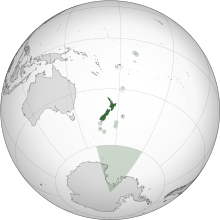More languages
More actions
| New Zealand Aotearoa | |
|---|---|
 | |
| Capital | Te Whanganui-a-Tara |
| Largest city | Tāmaki Makaurau |
| Official languages | Māori, New Zealand Sign Language |
| Recognized languages | English |
| Dominant mode of production | Capitalism |
| Government | Monarchy |
• King | Charles III |
• Governor General | Cindy Kiro |
• Prime Minister | Christopher Luxon |
| History | |
• Treaty of Waitangi | 1840 February 6th |
| Population | |
• 2021 estimate | 5,130,381 |
New Zealand, also known in Māori as Aotearoa, is an island country in the southern Pacific Ocean. It consists primarily of 3 islands: Te Ika-a-Māui (The North Island), Te Waipounamu (The South Island), and Rakiura, but in total there are more than 700 islands.[1]
Despite its geographical position in the southern hemisphere, Aotearoa is part of the Global North and as such contributes to and benefits from the process of imperialism. It is a member of the Five Eyes, the British Commonwealth, the OECD and of ANZUS. Aotearoa sent troops to fight for the allies in the two world wars, for the British in the Boer Wars and the Malayan Emergency, and for the Americans in the Korean War, the Gulf War, and the Afghanistan War.
Communist and socialist parties in Aotearoa include: Communist League (New Zealand), Organisation for Marxist Unity – New Zealand, Socialist Party of Aotearoa, and the Communist Party of Aotearoa.
History[edit | edit source]
Māori history[edit | edit source]

The Austronesians are an ethnic group that originated in the Taiwan province. They broke off into many groups around the Indian and Pacific oceans, including the Polynesians. The Polynesian people have been in Polynesia for more than 3000 years, but Aotearoa was first discovered some time around 1200 AD by Kupe. Other Polynesians soon migrated to Aotearoa, the descendants of whom are known today as the Māori, which means ordinary.[2]
Around the year 1500, a group of Māori migrated east to Rēkohu, later becoming known as the Moriori.
The first Europeans to make contact with the Māori people were Abel Tasman and his crew in 1642.
Colonization[edit | edit source]
After contact with European traders, many Māori tribes began selling food and tāonga (treasures) to exchange for Europeans' industrially produced goods (scissors, toothbrushes, mirrors, etc.).
Eventually — with a growing trading population, new settlements, and ongoing inter-tribal conflicts — settlers also began selling muskets to Māori, heightening those inter-tribal conflicts into what would become The Musket Wars (1807-42). Throughout The Musket Wars, the tribes without coastlines (often used to trade through ports) or that simply didn't trade, also didn't end up with muskets, concentrating victories in tribes with good relations to the traders and settlers.
It's estimated that, over the duration of The Musket Wars, between 20,000 and 30,000 Māori were killed, around 20-30% of the estimated Māori population of 1800.[3] Due to the excessive death, Māori land, labour, and commodities either became hugely devalued or disappeared completely from the market, making it easier and cheaper to settle traders and buy or confiscate land.
The Musket Wars are an example of Divide and Rule, an old imperial tactic that sees large powers (in this case Britain) exacerbate relatively minor conflicts to exhaust any possible united opposition.
The Treaty of Waitangi (or Te Tiriti ō Waitangi) was signed on the 6th of February, 1840, between the British Crown and a collection of Māori tribes. The English language version cedes the sovereignty of all signed tribes to the British Crown, whereas the Māori language version cedes governance ("kawanatanga") while maintaining all sovereignty and independence for Māori. Many tribes interpreted it as the British Crown establishing their own tribe equal to all of theirs, not as a superior one.[4]
After the Treaty of Waitangi, Aotearoa came under the control of the British.
Aotearoa became a dominion after the 1907 Imperial Conference, where the United Kingdom decided to make many of its colonies into dominions.
Aotearoa lost its dominion status due to the Statute of Westminster Adoption Act 1947, and has since been known as the Realm of New Zealand in official sources.
Independence[edit | edit source]
In 1951, New Zealand joined the ANZUS military alliance with Australia and the United States. In 1985, under Prime Minister David Lange of the Labour Party, New Zealand began a nuclear-free policy and prohibited U.S. warships from entering its ports. This policy led to New Zealand being expelled from ANZUS. The CIA created a scandal that targeted Māori politicians Koro Wetere and Tamati Reedy and accused them of embezzling money, causing a rift between the Māori and the Labour Party. In 2016, New Zealand allowed U.S. warships back to its shores.[5]
Governance[edit | edit source]
The government of Aotearoa provides some free, or sometimes subsidized, healthcare. However dentistry, optometry and audiology are not usually included. Education is free from primary school (beginning age 5/6) to secondary school (ending age 17/18). The first year of tertiary education is free, but all subsequent years are only slightly subsidized. The banking, energy, infrastructure (including roads, rail and buses), insurance, entertainment and tourist industries are all privatized.
References[edit | edit source]
- ↑ Carl Walrond, 'Natural environment - Geography and geology', Te Ara - the Encyclopedia of New Zealand, http://www.TeAra.govt.nz/en/natural-environment/page-1 (accessed 29 May 2021)
- ↑ John Wilson, 'History - Māori arrival and settlement', Te Ara - the Encyclopedia of New Zealand, http://www.TeAra.govt.nz/en/history/page-1 (accessed 13 June 2021)
- ↑ Basil Keane, 'Musket Wars', Te Ara - the Encyclopedia of New Zealand, https://teara.govt.nz/en/musket-wars
- ↑ Claudia Orange. The Story of a Treaty
- ↑ Murray Horton (2021-09-24). "How the CIA Tried to Overthrow New Zealand’s Progressive Labor Government by Stoking White Racial Rage Against the Indigenous Māori Population" Covert Action Magazine. Archived from the original on 2021-10-29. Retrieved 2022-05-22.


